|

Micscape readers sharing
aspects of where they live.
Title and series idea
by Dan Holloway.
|
Enjoying Field Studies
Council Courses (UK)
Part 1: 'Life in Ponds and
Streams' weekend course at Juniper Hall, Surrey.
by David Walker, UK
|
Series Introduction:
The Field Studies Council (FSC) have residential field centres around Britain where
courses of various lengths on a wide range of topics are offered. The author
attended a number of their natural history related courses in the 1980s
- 1990s
and thoroughly enjoyed them. Other courses include painting, photography, writing,
history etc. Overseas courses are also offered. Course tutors are experts in
their field. See article foot for links to further information.
My
personal experiences may be of interest to Micscape readers unfamiliar with
these courses and may also interest overseas readers considering
a visit to the UK and seeking an educational but enjoyable visit to some
of Britain's most beautiful areas.
Course
summary. 'Life in ponds and streams' weekend course. Tutor Richard Orton. Next course
August 1st-3rd 2008. Held at Juniper Hall field
centre, Surrey. The centre is ca. 20 miles SW of central London in a beautiful
setting at the foot of Box Hill in the North Downs. Good road and train access.
I've
had a casual interest in freshwater life since I was about ten (now the other
side of fifty) and prompted my lifelong interest in microscopy. I attended this weekend
course as it provided a gentle introduction
to topics such as freshwater ecology of ponds and rivers/streams, sampling techniques
and invertebrate identification for assessing water
quality using biotic indices.
I
didn't plan to take a comprehensive photographic record of the course (we were
kept busy!), so the article is illustrated with 'snaps' I did happen to
take. Aspects such as working in the well equipped labs with the centre's stereo
microscopes to ID the fauna found aren't shown.
Friday
evening: The
fellow members (ca. 10) on the course after our introductions were a blend of enthusiasts like myself and those with a more professional interest. The course
readily catered for both. The course aims were outlined by the tutor Richard Orton, a freshwater biologist. We
were to visit and sample two different ponds on the Saturday and two different
rivers on the Sunday. In the field some physical / chemical measurements
were also taken. Back at the centre's labs we would identify the type of invertebrates
found using published guides and try different biotic indices to assess the
quality of the habitats.
During
the course, practical studies were supplemented by talks, slide shows and printed handouts complemented
the studies.
The
habitats visited were all within a few miles of the centre so little travelling
in the centre's minibus was required.
Saturday.
Two contrasting ponds studied.
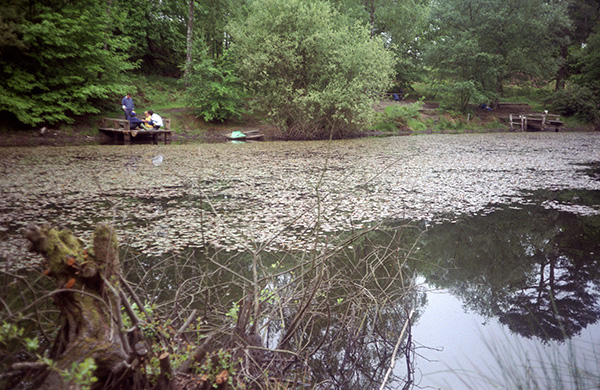
'Top
pond' Nower wood. The wood is a large reserve owned by the Surrey
Wildlife Trust and its varied
habitats are widely used as an educational resource. Pond dipping platforms
have been installed at the 'top pond' and there is also bird watching facilities.
It's a large pond and is surrounded
by trees which can affect its ecology.
Pond
surveys require different techniques to those for flowing water.
Selected procedures recommended by the UK National
Pond Survey were used.
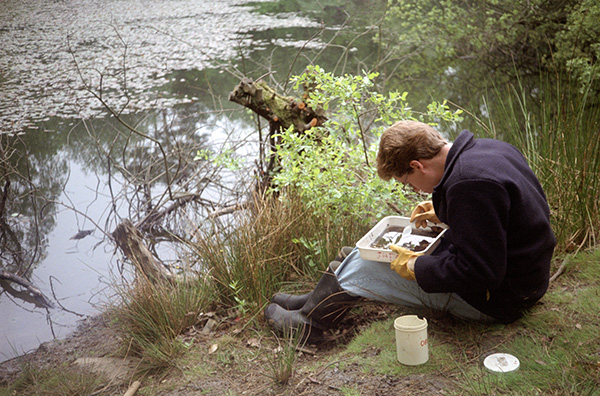
'Top
pond', a fellow course member Steven examining a catch. Invertebrates
requiring identification were transferred to pots for study in the centre
lab. Each course member had access to a stereo microscope, hand lens and
ID guides during the course with help from the tutor. Course members helped
each other as well.
Note
the rubber gloves, hygiene is important during pond and stream sampling,
especially in our group where we would be later eating our packed lunch.
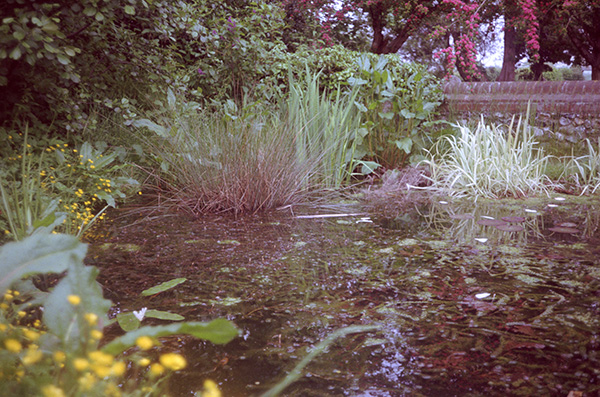
Church
pond in the village of Headley. This was a very different pond to that in Nower wood. It was smaller with a
healthy growth of pond side and extensive aquatic vegetation. It's one of the
most attractive ponds I've seen; in June at time of visiting the flowers were
in bloom and the site was complemented by its ecclesiastical setting.
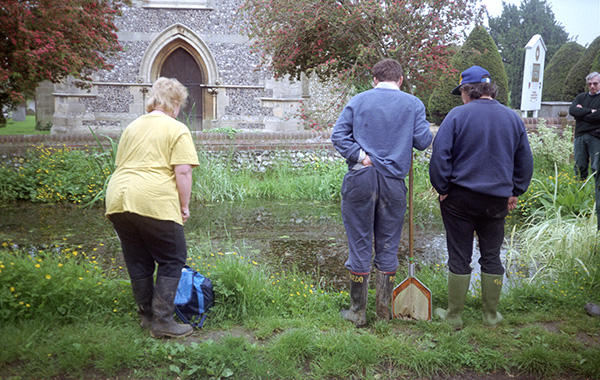
Church
pond with local parish church in the background.
The church and graveyard wall are faced with large flints, a common
feature in the local buildings because 'clay
with flints' occurs in the area.
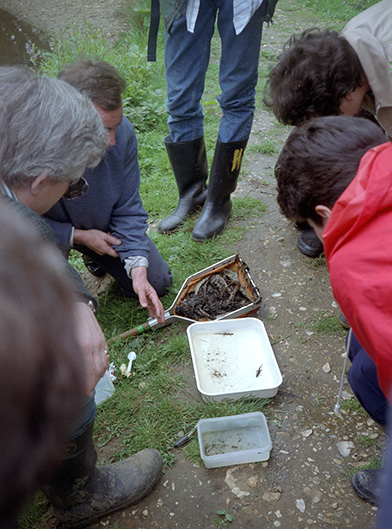
Church
pond. Examining a catch. Two newts are in the tray. Note the professional
pond net with reinforced edges to prevent net damage and the flat base to aid kick sampling
in streams, see below.
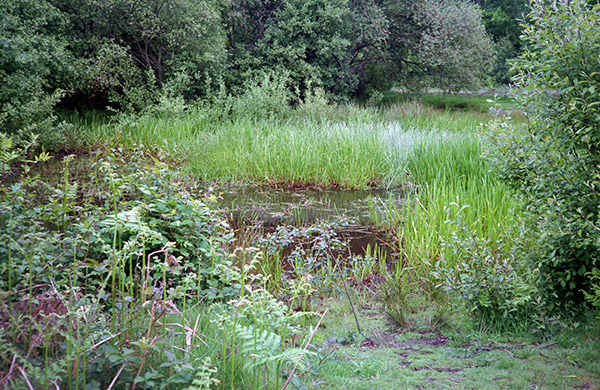
Pond,
Headley Heath. Although not sampled we visited this attractive pond on the heath
just east of Nower wood to compare its features with that at Nower Wood
and the church pond.
Sunday.
Two contrasting flowing water courses studied.
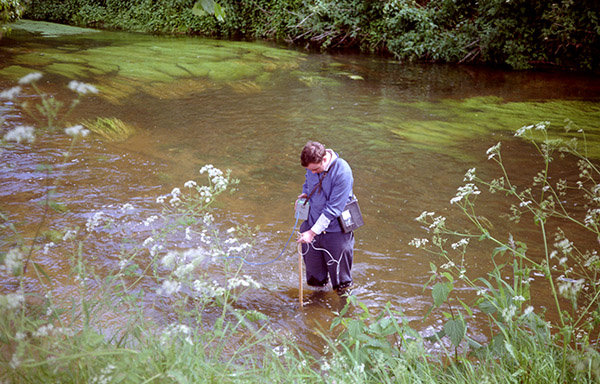
Rive
Mole at Burford Meadows. As the picture shows this is a large river and
a major one in Surrey. The course tutor is taking measurements of key river parameters—flow rate
and oxygen level. Nitrate levels were also determined with test trips. Note the tutor's devotion to the task, the water is over
the tops of his wellington boots ('wellies'). The tutor remarked that the
level was higher than usual due to recent rain so needed care.
If travelling
to the centre by public transport, as the author did, there's no need to bring bulky waterproof boots and clothes, these are
available to borrow at a centre.
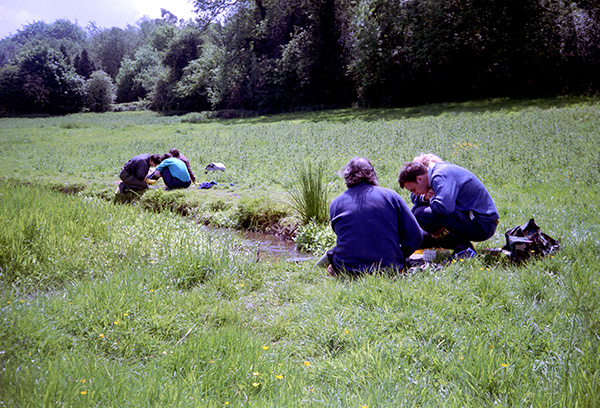
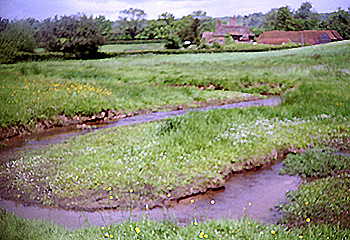
River
Tillingbourne near Cross Ways Farm. A very different water course to the River Mole. A narrow stream gently
meandering through lush meadows. What an idyllic way to study freshwater life—sunny
weather, a beautiful, peaceful setting and examining a superb water course under
expert tutorship with like minded course members.
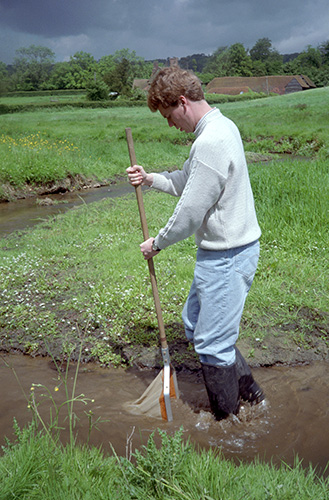
River
Tillingbourne. A fellow course member Steven taking a so-called kick sample
from the stream. The bottom is agitated for a fixed time (we used 30 seconds)
with the boots while
holding a net immediately downstream to collect all fauna dislodged.
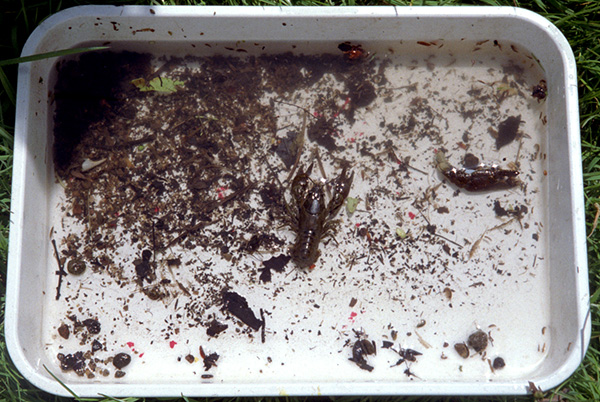
River
Tillingbourne. One of the samples collected, showing a native freshwater
crayfish in the centre and what may be the claw of a larger specimen to the
right. This was first time the author had seen a live native crayfish which
is apparently being threatened in the UK by an invasion of the American
signal crayfish.
The
lab studies were very instructive and enjoyable. The FSC's own excellent 'Freshwater
Invertebrates' guide
was used (available from their online bookshop). The biotic indices tried only required
identification of fauna to family so was well within the capabilities of course
attendees at all levels. The indices were carefully explained and printed
data sheets allowed them to be readily worked out.
The BMWP index was mainly
used which essentially
gives a score for each organism family found depending on its
tolerance to pollution, so an oligochaete worm scores 1 whereas pollution
intolerant
species such as mayflies score 10. A total for all the organisms found gives
the water body its overall score. See Wikipedia
for BMWP score table. I won't do a 'spoiler' of the course and remark on the fauna
found and each habitat's scores as comparable site visits may
still be part of the course.
General
comments
I
can thoroughly recommend this course which is still current and led by the same
course tutor who was excellent. Since attending the course I've had a stab at
assessing the water quality using biotic indices of small local streams
(rather than larger water courses), both in
London where I lived then and now in Huddersfield, where there are plenty of
upland streams safe to study. The author's own stream dipping outfit made from suitable accessible materials
is shown below. Studies can be supplemented by simple measurements of water chemistry, using the
kits sold to aquarists and/or the increasingly portable meters now available.
See links below.
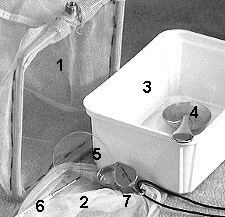 1) Strong home-made sampling net
made from a square wire frame (threaded for handle) using netting from a local
drugstore (mesh size 0.9mm, sold as home brewing coarse filter
bag).
1) Strong home-made sampling net
made from a square wire frame (threaded for handle) using netting from a local
drugstore (mesh size 0.9mm, sold as home brewing coarse filter
bag).
2) Smaller net
for sampling smaller streams (net sold in pet shop for handling aquarium
fish). Some
of the steams are so small in my local area, I tried a hand rather than
kick sampling method.
3) Plastic
container for examining catch. Ice cream or margarine tubs are ideal. Small
photographic developing trays are also useful.
4) Old tablespoon for collecting gravel or sand
samples and handling larger invertebrates. Plastic tea strainers are also
useful.
5) Small glass
watchglass for examining selected organisms.
6) Artists paintbrush for removing eg insect larvae
from submerged stones.
7) ... and the not to be forgotten 10X hand lens.
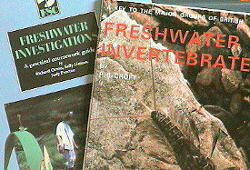 There a number of very useful books
for the non-specialist describing stream dipping techniques, and simple keys to
identify what you find. Two are shown right, both published by the Field Studies
Council.
There a number of very useful books
for the non-specialist describing stream dipping techniques, and simple keys to
identify what you find. Two are shown right, both published by the Field Studies
Council.
1) Freshwater Invertebrates by P S
Croft. Reprint from Field Studies, 1986, (6), 531-579. This was the main guide
used on the course. It's a well
illustrated simple key to identify creatures larger than 2mm to a major
biological group and some to families or species. It was specially designed for
students and makes use of easily seen features in living organisms while at the
stream (and pond) side and is excellent value.
2) Freshwater Investigations - A
practical coursework guide by R Orton (our course tutor), S Haines, J Proctor. Field Studies
Council, 1995, ISBN 1 85153 832 1. This guide deals with all aspects of planning
and carrying out freshwater investigations in a very readable style with
delightful cartoons and drawings to get the message across. Although designed
for young students taking course work it is very valuable for amateurs of all
ages and includes a discussion of safety aspects and types of project you can
undertake.
Comments to the author David Walker are welcomed.
Resources
on the Field Studies Council website. Homepage.
Juniper
Hall overview. 'Life
in ponds and streams' course; still current, next course August 1st - 3rd,
2008.
A
longer course on a similar topic 'Identifying Freshwater Invertebrates for Biological
Surveying and Recording' (tutor Adrian Chalkley) is being held at the Flatford
Mill Field Centre, Suffolk in September. The FSC also publish a range of superb identification
guides on many groups of fauna and flora for the youngster, beginner
and expert.
Accommodation
can vary between centres, from shared rooms to single rooms. Juniper
Hall has a modern additional single room residency block in addition to
the splendid
main house which is 18th century. The centre is well equipped with labs which include stereo
microscopes, ID guides and a well stocked library. Many centres have a bar,
the courses are educational but are meant to be enjoyed in all senses! The courses
are very good value.
Selection
of County of Surrey resources: Wikipedia: North
Downs, Rivers
of Surrey (entry on both the Mole and
the Tillingbourne). Juniper Hall: www.boxhill.org.
Headley village and church www.headleysurrey.org.
Micscape
resources:
Stream
dipping. An introduction. The author's stab at a Micscape resource, by a
beginner, for beginners!
Topical
Tips 15: Using aquarist's kits for simple water analyses. (Also mentions
cheap pH and conductivity meters.)
©
Microscopy UK or their contributors.
Published in the July
2008 edition of Micscape.
Please
report any Web problems or offer general comments to the Micscape Editor .
Micscape
is the on-line monthly magazine of the Microscopy UK web site at Microscopy-UK
© Onview.net Ltd,
Microscopy-UK, and all contributors 1995 onwards. All rights reserved.
Main site is at www.microscopy-uk.org.uk with full
mirror at www.microscopy-uk.net .












 1) Strong home-made sampling net
made from a square wire frame (threaded for handle) using netting from a local
drugstore (mesh size 0.9mm, sold as home brewing coarse filter
bag).
1) Strong home-made sampling net
made from a square wire frame (threaded for handle) using netting from a local
drugstore (mesh size 0.9mm, sold as home brewing coarse filter
bag).  There a number of very useful books
for the non-specialist describing stream dipping techniques, and simple keys to
identify what you find. Two are shown right, both published by the Field Studies
Council.
There a number of very useful books
for the non-specialist describing stream dipping techniques, and simple keys to
identify what you find. Two are shown right, both published by the Field Studies
Council.